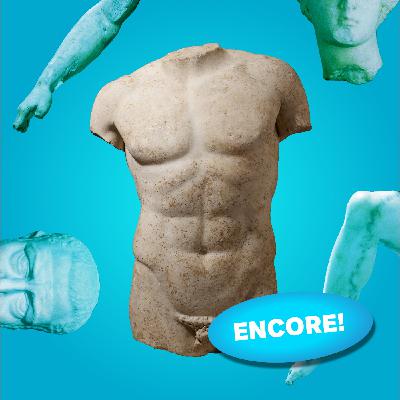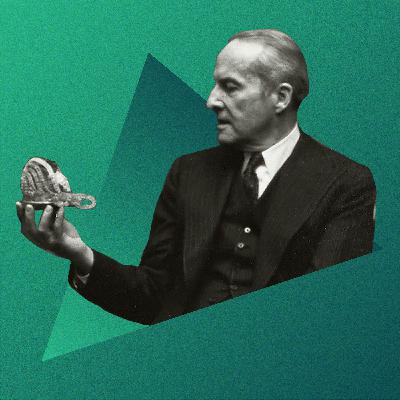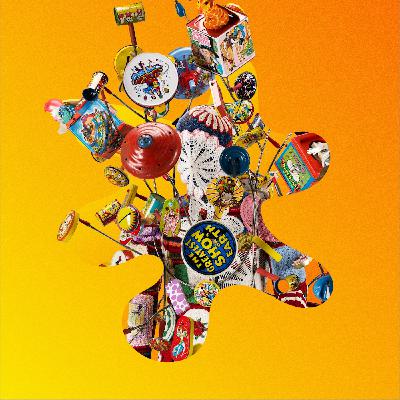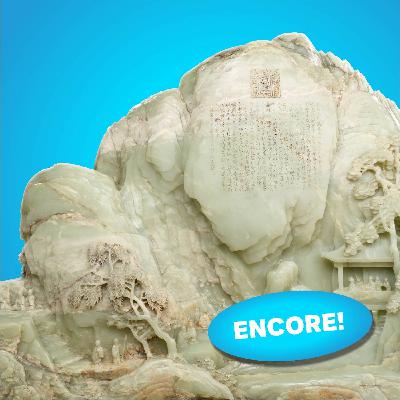Discover The Object
The Object

The Object
Author: The Object podcast from the Minneapolis Institute of Art
Subscribed: 145Played: 2,443Subscribe
Share
© All rights reserved
Description
”The Object” podcast explores the surprising, true stories behind museum objects with wit and curiosity. An object’s view of us. Hosted by Tim Gihring, produced by the Minneapolis Institute of Art.
95 Episodes
Reverse
Tickets are going fast for our next exclusive live taping of The Object podcast on October 30 at the Minneapolis Institute of Art, with special guest Chan Poling (The Suburbs, The New Standards), fun quizzes, curator conversation, and of course storytelling—all about the 100th anniversary of The Great Gatsby and the art of the Jazz Age. Tickets are absolutely FREE but you do need to have them. Go to the Tickets page at Artsmia.org and get yours today!
And now, today's episode:
Artists have captured unicorns for thousands of years, and for most of that time people thought they were both magical and real. What can an imaginary creature tell us about ourselves? What did we lose when we stopped believing? And why do we still love them anyway?
You can see unicorns in art through the ages in the collection of the Minneapolis Institute of Art, including a "millefleurs" tapestry from the late Middle Ages, a remarkable 1555 engraving of "A King Pursued by a Unicorn" by Jean Duvet, and Albrecht Dürer's "Abuction on a Unicorn" from 1516.
Thanks to Natalie Lawrence and Marguerite Ragnow for sharing their expertise on this episode.
Lawrence is a freelance writer with a PhD from the University of Cambridge on exotic monsters in early modern Europe. Check out her new book, Enchanted Creatures: Our Monsters and Their Meanings.
Ragnow is a historian and curator of the James Ford Bell Library at the University of Minnesota, a collection about trade and exploration, featuring rare books, maps, and manuscripts. She is working on a book about unicorns.
Vienna in the early 1900s is a kind of paradise of power and beauty, the center of an empire that will seemingly go on forever. Only an eccentric young artist, who sees faces in trees and finds God in the forest, seems to understand the fall that is coming. A loss of innocence that will consume him—and much of the world.
You can see the work of Egon Schiele, Josef Hoffman, and the other artists, designers, writers, and philosophers mentioned in this episode in the new exhibition "Timber! Art and Woodwork at the Fall of the Austro-Hungarian Empire" at Mia.
Save the date: The next live taping of The Object podcast will be October 30 at 7 p.m. at the Minneapolis Institute of Art, absolutely free. Special guest and ticket info coming soon. Now, enjoy this encore episode about a story as old as life itself: things fall apart. But what really happened to all those ancient statues missing arms, legs, heads, and other appendages? And how have we come to treat them as normal—a normal way of seeing the classical age, like paintings of the Renaissance or black-and-white photos of the 1900s? Have they shaped a perception of the past as more remote, mysterious, and, well, broken than it really was?
See some of the battered artworks mentioned in this episode, including the Tiber muse, a Graeco-Roman torso, an ancient Egyptian figure, and the Venus de Milo.
Truth and fiction collide in two stories of museum life. One of a curator who goes missing in the 1950s. The other of a curator who finds himself in the aftermath of World War I, a life chronicled in diaries recently found inside a forgotten storage space. A life filled with beauty and tragedy and the redemptive power of art.
Save the date: The next live taping of The Object is October 30 at 7 p.m. at the Minneapolis Institute of Art, all about the 100th anniversary of The Great Gatsby, F. Scott Fitzgerald, and the art of the Jazz Age. Guests and details coming soon!
The Renaissance, which began in Italy some 700 years ago, may be one of the last true ideals we have. It's this beacon of beauty and truth that led us out of the Dark Ages. It gave us Leonardo da Vinci, Michelangelo, and Raphael. But the Renaissance was also extremely, delightfully weird. A story of what happens when repression recedes and freedom moves in—and how this strangeness gave us our modern world.
You can see some of the "weird" artworks discussed in the episode here. Then, if you're able, see them in person at the Minneapolis Institute of Art.
New episode! In the 1920s and ’30s, Mary Sully makes her way from Standing Rock Reservation in South Dakota to New York City and then around the country, making surprising, delightfully abstract portraits of American celebrities: Fred Astaire, Shirley Temple, Amelia Earhart. “Personality prints,” she calls them, though the most intriguing personality they reveal might be her own. A personality and a story that challenges everything you think you know about Native America—and all of America—in the early 20th century.
You can see Mary’s “personality prints” the Minneapolis Institute of Art this summer. Photo courtesy of the Mary Sully Foundation.
Kicking off Pride Month with a surprisingly epic encore episode about Grant Wood. In the 1930s, the Iowa artist is one of the most famous people in America. The mind behind "American Gothic"—the painting of the man, the woman, and the pitchfork. An artwork so celebrated and so curious it’s called the “modern Mona Lisa.” But as times change and jealousy spreads, Wood suddenly finds himself fighting for his life and livelihood, protecting a secret he hid almost everywhere but in his art.
You can see Wood’s quirky, nostalgic style in "The Birthplace of Herbert Hoover," in the collection of the Minneapolis Institute of art.
Some see a tender self-portrait in "Sentimental Yearner," a drawing made for Sinclair Lewis’s "Main Street."
The next live taping of The Object is May 11—the show is sold out, but don't forget to come if you have tickets and watch for the next live taping coming up.
This encore episode reprises last year's popular episode about one of our oldest relationships with a non-human: dragons, and the very different ways we've imagined them in different parts of the world. Helping or hurting, making rain or breathing fire. The difference, of course, is us. Here, a brief, beastly history of the creature we can’t live with—or without.
You can see many manifestations of dragons, European and Asian, in Mia’s collection.
New episode! It is the stuff of legend, how Claude Monet discovers Japanese art in the late 1800s and becomes one of the most famous artists in the world. But one influence is as real as he is mysterious. The artist behind the "great wave" and hundreds of other iconic images. The artist who calls himself Hokusai (at least for a time), and only becomes more powerful after he's gone.
You can see art by both Monet and Hokusai, side by side, in the show "Hokusai / Monet" on view at the Minneapolis Institute of Art through August 10.
If you snagged tickets to the next live taping of The Object, with Dessa, on May 11—nice work! They're now sold out. In the meantime, enjoy this encore presentation of one of our most popular episodes ever. He was the original rebel with a cause, dedicated to showing the world a new way of seeing. But what if Claude Monet's real cause was...Claude Monet? What if his rise from scorn and poverty to become one of the most beloved and wealthy artists in history was fueled by myth and marketing? Can we love him anyway?
You can see Monet's work, well, almost everywhere. But you can see it now, in conversation with the art of Japanese artist Katsushika Hokusai, at Mia: https://new.artsmia.org/exhibition/hokusai-monet
Big news! It’s the first episode of Season 7 AND tickets are now available for the next live taping of The Object podcast, featuring musical guest Dessa, quizzes, curator conversation, and storytelling on Sunday, May 11, at 2 p.m. at the Minneapolis Institute of Art. All about surrealism, humor in art, and Mia’s beloved Aphrodisiac Telephone by Salvador Dalí—on his 121st birthday! It’s “Your Lobster is Ringing!,” the second and biggest edition yet of The Object LIVE! Tickets are FREE but limited. Reserve your seats now by going to the tickets page on the Mia website or follow this link: https://tickets.artsmia.org/events/0193e565-7c1c-d9d9-1b45-09cd98f22f2c
And now, today’s episode:
Nick Cave is a young Black art professor in Chicago when, in the 1990s, he makes his first “Soundsuit.” A kind of musical armor, born of pain and pride and self-preservation. He’s now made more than five hundred, adding to the long and fascinating history of going incognito to truly be oneself. A powerful story of the lengths we all go to be both seen and heard.
You can see a soundsuit from 2010 in the collection of the Minneapolis Institute of Art: https://collections.artsmia.org/art/111576/soundsuit-nick-cave
(Listen for a rare "performance" of the Mia soundsuit in this episode.)
Or in the “Giants” exhibition of art from the Dean Collection of Swizz Beatz and Alicia Keys, now on view at Mia: https://new.artsmia.org
The seventh season of The Object begins March 24!
Today, an encore presentation of an episode about Joe Minter and the "yard show" artists of Alabama. Thirty-five years ago, Joe Minter received a vision. Soon, his half-acre property outside Birmingham, Alabama, began to fill with sculpture—reflections on everything from slavery to 9/11 to climate change—fashioned out of junk: car parts, toys, industrial detritus, gizmos of all sorts. An elaborate example of the Southern Black tradition of the yard show, with Minter as its genial showman. Now, it's among the last of its kind, and as museums and collectors come calling, the race is on to determine the fate of Minter’s art and how to think about it.
You can see Minter's art in Alabama, of course, and at the Minneapolis Institute of Art: https://collections.artsmia.org/art/132218/voyage-in-chains-joe-minter
Season 7 of The Object starts March 24! Here, a special episode from the archives about Love and Art in capital letters.
When the young Italian artist Amedeo Modigliani moves to Paris, in the early 1900s, he soon meets a very talented (and very married) Russian poet. What happens when Love and Art come together, as the rest of the world is falling apart?
You can see one of Modigliani’s iconic Head sculptures, in the collection of the Minneapolis Institute of Art, here: https://collections.artsmia.org/art/1502/head-amedeo-modigliani
(Spoiler alert) You can see a close-up of the secret fossil discussed on the show here.
This first-ever live show of The Object podcast (recorded at the Minneapolis Institute of Art on January 23, 2025) features music and storytelling celebrating French painter Édouard Manet and his Impressionist friends and frenemies (yes you, Monet). Watch for more live shows coming soon!
You can see one of Manet's portraits, as discussed on the show, in the collection of the Minneapolis Institute of Art: The Smoker.
On the 90th anniversary of the groundbreaking Tatra automobile, we bring you this encore episode from The Object's first season. A story of the last major war in Europe, when nothing seemed capable of slowing the Third Reich—except, the legend goes, the very fast, very unusual Tatra car from Czechoslovakia. A poignant tale of poetic justice, grace in wartime, and the utopian future that wasn't. You can see a Tatra T87 in the collection of the Minneapolis Institute of Art: https://collections.artsmia.org/art/98653/tatra-t87-four-door-sedan-hans-ledwinka
She was one of the most recognizable women in the world, her long copper hair filling painting after painting, even if few people knew her name: Cornforth. Model, muse, and mistress to the most influential artists of the Victorian era, she still had to fight for everything she got. Until, in the end, she lost the one thing she could count on for sure: herself.
You can see in this 1868 painting, "I know a maiden fair to see," in the collection of the Minneapolis Institute of Art: https://collections.artsmia.org/art/83645/i-know-a-maiden-fair-to-see-charles-edward-perugini
You can see the photograph mentioned in this episode--of , posing beside a mirror--here: http://www.rossettiarchive.org/docs/sa223.rap.html
When World War II began, nothing seemed capable of slowing the Third Reich. Except a very fast, very unusual Czech automobile called the Tatra. A poignant story of poetic justice, grace in wartime, and the utopian future that wasn't.
Big news! Tickets are now available for the next edition of The Object LIVE! Our hour-long live taping of The Object podcast on October 30, with very special guest Chan Poling of The Suburbs and New Standards, quizzes, and storytelling. All about the 100th anniversary of The Great Gatsby, the joys of jazz and St. Paul, and maybe the proper occasion to wear an ascot. Which is quite possibly this show—it’s “Great Gatsby’s Ghost!” The day before Halloween—Thursday, October 30, at 7 p.m. at the Minneapolis Institute of Art. Tickets are FREE but limited. Reserve your seats now by going to the tickets page on the Mia website, or follow this link: https://new.artsmia.org/event/the-object-live-presented-by-ameriprise-financial
And now, today’s episode:
In the fall of 1930, Frida Kahlo and Diego Rivera travel to the United States for the first time, welcomed as celebrity artists, ambassadors of an ancient and powerful Latin American identity. But as the months turn to years, can Rivera’s vision of one united Pan-America—and his marriage—survive the pressures of politics, fame, temptation, cultural differences, and scandal?
You can see examples of Diego Rivera’s work, and that of other modernist Mexican artists, in the collection of the Minneapolis Institute of Art: https://collections.artsmia.org/search/Diego%20Rivera
You can see Rivera’s San Francisco mural “Pan American Unity,” discussed on the show, here: https://www.sfmoma.org/exhibition/pan-american-unity/
You can see photos of Frida and Diego taking San Francisco by storm here: https://www.kqed.org/news/11848986/inside-frida-kahlo-and-diego-riveras-life-in-san-francisco
You can see (and read) Kahlo’s heartfelt letter to Rivera from a San Francisco hospital (“Diego, mi amor”) in the collection of the Smithsonian: https://www.si.edu/object/frida-kahlo-letter-diego-rivera%3AAAADCD_item_739
Save the date: The next free live taping of The Object podcast will be October 30 at 7 p.m.! Special guests and ticket info TBA. Now, enjoy this encore episode about one of the largest jade sculptures in the world, a 640-pound mountain commissioned by the Chinese emperor. In 1901, in the ugly aftermath of the Boxer Rebellion, it ends up leaving China—only to resurface on the dinner table of a lumber baron. It’s a story as old as stone: can anyone be king of the hill for long?
You can see "Jade Mountain Illustrating the Gathering of Scholars at the Lanting Pavilion," now in the collection of the Minneapolis Institute of Art, here.
Truth, beauty, transcendence. For millennia, people think they know the rules of great art. Then, in the 1950s, a guy named Bob breaks every one of them, declaring car tires and Coke bottles and entirely blank canvases part of his art—and, in turn, being declared the greatest artist of his time. As war gives way to optimism, is Robert Rauschenberg offering a weary world a new way of seeing, or is he simply, entertainingly, and quite lucratively bamboozling it?
Here, you can see Rauschenberg's 1970 exhibition at Gallery 12, atop Dayton's department store in Minneapolis: www.rauschenbergfoundation.org/art/archi…allery-12
Here's an iconic print, commissioned but ultimately rejected by Time magazine in 1969, acquired the following year by the Minneapolis Institute of Art when the museum held a major retrospective of his prints: collections.artsmia.org/art/7519/sign…-rauschenberg
And here's an incredible shot of a boat hauling Rauschenberg's massive canvas across Venice for the 1964 Biennale: www.rauschenbergfoundation.org/art/archi…-biennale






















